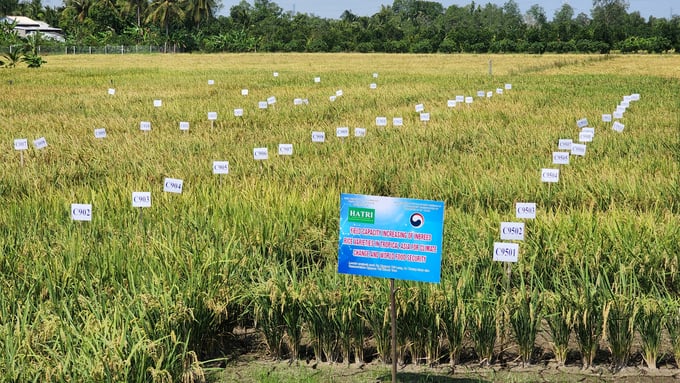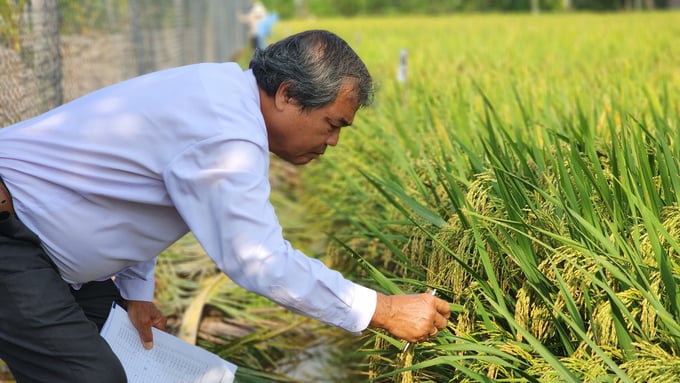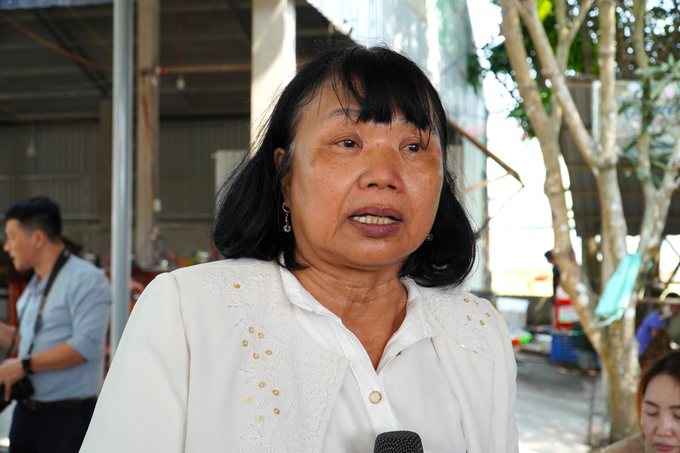
Field demonstration of a number of rice varieties with resistance to pests, alum, salt, good quality and high yield by the Mekong Delta High-Tech Agricultural Research Institute (HATRI). Picture: its metal.
On February 21, at the Mekong Delta Scientific Conference on the Assessment of Rice Varieties for Climate Change, the Mekong Delta High-Tech Agricultural Research Institute (HATRI) demonstrated and introduced a series of resistant rice varieties, pests and diseases, tolerance to salt alum, good quality, high yield. There are also a number of rice varieties that have been crossed between Vietnamese rice varieties and some countries around the world.
The highlight is the rice variety HATRI 200, a potential specialty rice variety that has been researched by HATRI since 2017 and is grown in the tropics. The rice variety HATRI 200 was first discovered in Ben Tre as part of the research project “Assessment of salt-tolerant rice varieties and their quality for climate change in the Mekong Delta” by Prof. Dr. Nguyen Thi Lang, head of the HATRI institute, tested.

Rice variety HATRI 200 was first tested in Ben Tre, after 3 seasons it showed very good drought and salt adaptation efficiency in the provincial countryside. Picture: its metal.
Ben Tre is one of the places frequently affected by drought and salinity. Recently, the province has sought and planted many salinity-tolerant rice varieties, but most rice varieties can only withstand salinity levels of about 2 parts per thousand. After receiving the transmission from HATRI, the HATRI 200 variety was produced in the Ben Tre area with the expectation that this will be a suitable rice variety that will help farmers to produce 3 rice plants per year. This rice variety has the advantage of a growing time of 95-100 days, hard stems, good tillering capacity of 10-13 buds/bush. Characteristics of round grain of rice, length 6.2mm.

HATRI 200 rice variety with the advantage of a hard stalk, good tillering capacity from 10-13 shoots/bush, round rice grain, length 6.2 mm, drought and salt tolerance up to 5 per thousand. Picture: its metal.
According to Prof. Dr. Nguyen Thi Lang, the HATRI 200 rice variety has very good tolerance to drought and salinity, up to 5 parts per thousand. This is considered one of the most salt-tolerant rice varieties in the Mekong Delta. In particular, the rice variety HATRI 200 has a stable average yield of 6.5-7 tons/ha. The successful research and hybridization of the high-quality HATRI 200 rice variety, which has the advantage of drought and salt tolerance, not only helps farmers to cultivate favorable conditions in the context of climate change, but also improves the value of rice grains and ensures standards for export markets.
After three seasons of national testing, the rice variety showed good drought resistance in Ben Tre and Tra Vinh provinces. Currently, HATRI is carrying out the procedures for the approval of the HATRI 200 rice variety for marketing.
Prof. Dr. Nguyen Thi Lang also pointed out that for the cultivation of drought- and salt-resistant rice varieties, both communities and farmers must adopt mechanized, intelligent and adaptive rice cultivation solutions. Specifically, such as: use of cluster seeders, sensible and environmentally friendly fertilization methods, integrated pest management (IPM) … This will help farmers to reduce production costs and promote them.

Prof. Dr. Nguyen Thi Lang, director of HATRI, noted that farmers need to adopt mechanization, smart and adaptable rice cultivation solutions to cultivate drought-resistant and salinity-resistant rice varieties with high efficiency. Picture: its metal.
Besides the HATRI 200 rice variety, which is resistant to drought and high salinity, there are also some promising rice varieties with good drought and salt tolerance that have been studied by HATRI, such as: e.g.: HATRI 930, HATRI 929, HATRI 50, HATRI 9, HATRI 195, HATRI 183…
In the last 5 years, the “seed bank” at HATRI has grown to over 1,000 varieties. About 30 varieties were supplied for trial plantings to locations in the Mekong Delta and central region; 5 types of rice have been tested and may be marketed; 3 important rice varieties for export have been handed over to companies. In the process of transferring varieties of rice to places, the institute also cooperates with a number of companies to carry out product releases for farmers and cooperatives.

